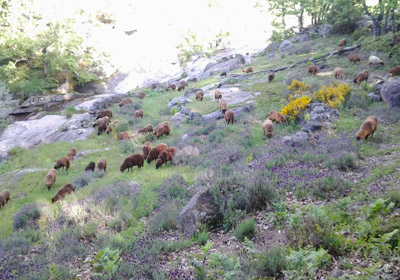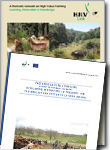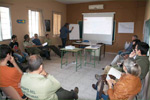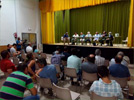La Vera, Extremadura, Spain

La Vera, Extremadura
La Vera is a district in the north-east of Extremadura (Spain) occupying the southern slopes and foothills of the Gredos mountains, ranging from approximately 400 to over 2000 metres and bounded to the south by the river Tiétar. The upland landscape is a mosaic of grassland, scrub and forest, the result of extensive grazing by goats, sheep and suckler cattle, with small terraces of olives, cherries, chestnuts, figs and other permanent crops. Most of the uplands of La Vera are designated under Natura 2000 as SAC ES4320038: Sierra de Gredos y Valle del Jerte. This site covers over 40,000 ha, of which 40% is within the district and includes a large part of the HNV grazing system.
The HNV grazing system is in severe decline, with consequent land abandonment putting at risk the pastoral habitats of Natura 2000 and leading to an increasing incidence of large-scale devastating wild fires. The key challenges facing the HNV grazing system are: lack of economic viability, high labour requirement especially for goats (shepherding and milking), the national/regional CAP model that is weighted heavily against upland grazing systems and provides almost no incentives to maintain the activity, low social status of graziers, lack of institutional support, many regulatory restrictions (e.g. preventing artisan cheese making).
Needs for innovation are multiple, including: a joined up institutional approach for maintaining upland grazing, using CAP options to provide payments that reward extensive grazing, better organization of labour, management planning and improvement of common pastures, networks of mutual farmers' support, increased added value to produce, and adaptation of the regulatory framework for farmers and cheese-makers.
For more information on the HNV farming systems, challenges and innovations, see the innovations page of La Vera.
More info: hnvlink.entretantos.org
Contact person:
Participatory approach
The HNV-Link project in Spain is represented by European Forum on Nature Conservation and Pastoralism (EFNCP) and Entrentantos. The two organisations teamed up to initiated HNV-Link in La Vera with a largely blank slate: there had been no previous project or process to engage with the community of extensive livestock farmers or to address the challenges they face at a territorial scale. The only prior projects were some small academic studies and a couple of local projects for rare breeds and agri-tourism. This community of farmers has been largely ignored by all levels of government (and by society at large) and is severely threatened with extinction. Absence of dialogue, awareness and understanding on the side of the regional authorities is evident in policies that are very poorly adapted to the circumstances of these farmers and the territory they manage. Within this context, HNV-Link initiated a process for more sustainability and innovation to build a future for these pastoralists and for HNV farmland.
The team started by building a database of farmers and other relevant actors (councils, cooperatives, authorities, nature wardens, extension services, researchers, etc.) with 99 entries in total. The team then conducted a round of bilateral interviews with a cross-section of these actors. It carried out 22 fully structured interviews (including 4 goat farmers, 4 cattle farmers and 2 representatives of the local farmers’ association) and several more unstructured interviews.
The interview process was very time-consuming but essential for gathering information and getting an understanding of different actors and their viewpoints for HNV-Link’s Baseline Assessment, to establish constructive relationships, and to prepare the ground for thematic workshops and building the vision for HNV farming in La Vera.
During the course of several months in 2017, the team organised a series of thematic workshops with farmers, producers, scientists and other actors. This included a specific innovation seminar to refine the future vision for HNV farming in La Vera and to discuss and propose innovation priorities for the next phase of the project.
These events are part of a wider process for supporting livestock-based HNV farming that has been running since the project began and continues through 2018. For example, Entretantos has been in constant dialogue with a small number of farmers from the local graziers’ association and has been supporting them in their biggest current concern - the government’s high-impact TB eradication campaign. Here, HNV-Link is playing a key role in promoting constructive dialogue by initiating and facilitating a series of meetings between farmers and regional authorities to discuss adaptations to the TB campaign. To assure a sustainable future for HNV farming, the team is, through numerous meetings with different departments during 2017 and 2018, discussing with the government a range of policy issues that need resolving. They have also had meetings with the municipalities and organised a joint written request to the regional government for more action in support of extensive grazing in La Vera.
Table 1: List of participatory events in Learning Area La Vera, Spain (up to April 2018)
| Activities (links are to Spanish website) | Number of participants | Date |
|---|---|---|
| Interviews with farmers and other stakeholders | Oct 2016-March 2017 | |
| Workshop on products and processing | 16 | April 2017 |
| Workshop on conservation of pastoral landscapes and habitats | May 2017 | |
| Seminar on innovation proposals | July 2017 | |
| Seminar on TB eradication campaign | 45 | Sept 2017 |
| Meetings with Regional Government departments | Feb 2017-Oct 2018 | |
| Practical case study – Garganta la Olla | Oct 2017-Oct 2018 | |
| Regional/National innovation seminar – Territorios Pastoreados | April 2018 |
Finally, EFNCP established a practical case study in one municipality, Garganta la Olla, where the they are undertaking a more intensive process with participation of nearly all of the farmers (approx. 10 in total) and other actors (council, foresters, hunters) in order to develop practical proposals for innovative actions for improving the viability of sustainable grazing practices as a livelihood. It is clear that without such actions, especially from the authorities, extensive grazing will disappear from this municipality within a few years, and the mosaic of Natura 2000 habitats that make up most of the landscape will be lost.
Gallery
Video
Disclaimer: This document reflects the author's view and the Research Executive Agency is not responsible for any use that may be made of the information it contains.
Outputs
-
 La Vera, Extremadura, Spain LA
La Vera, Extremadura, Spain LA
- Baseline Assessment
- Report from the Innovation seminar
- Innovation report
- Proceedings from event 27-28 March 2017: Territorios Pastoreados 2 (national language)
- Participatory approach, La Vera, Extremadura, Spain LA
- Report Grazing and conservation in the El Monte De Garganta La Olla - Pastando Garganta
- La Vera, Extremadura, HNV-Link Final Conference (Poster)
- Action Plan
(April, 2019)The compilations of the respective reports from all project learning areas - Baseline Assessments, Reports from innovation seminars, and Compendium of Innovation - can be found in 'Outputs'. Reports from the Innovation seminars are in the national languages, all other materials are in English.





